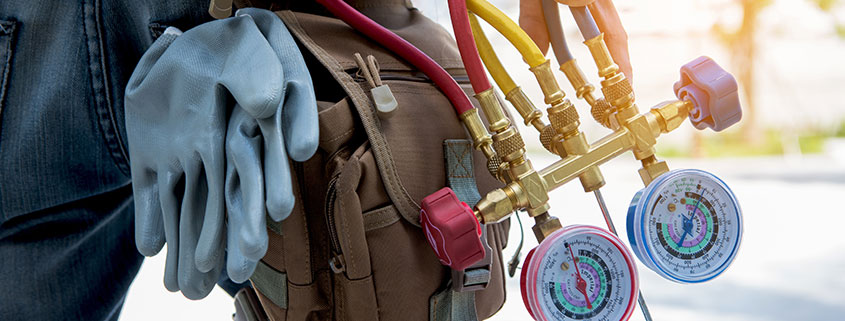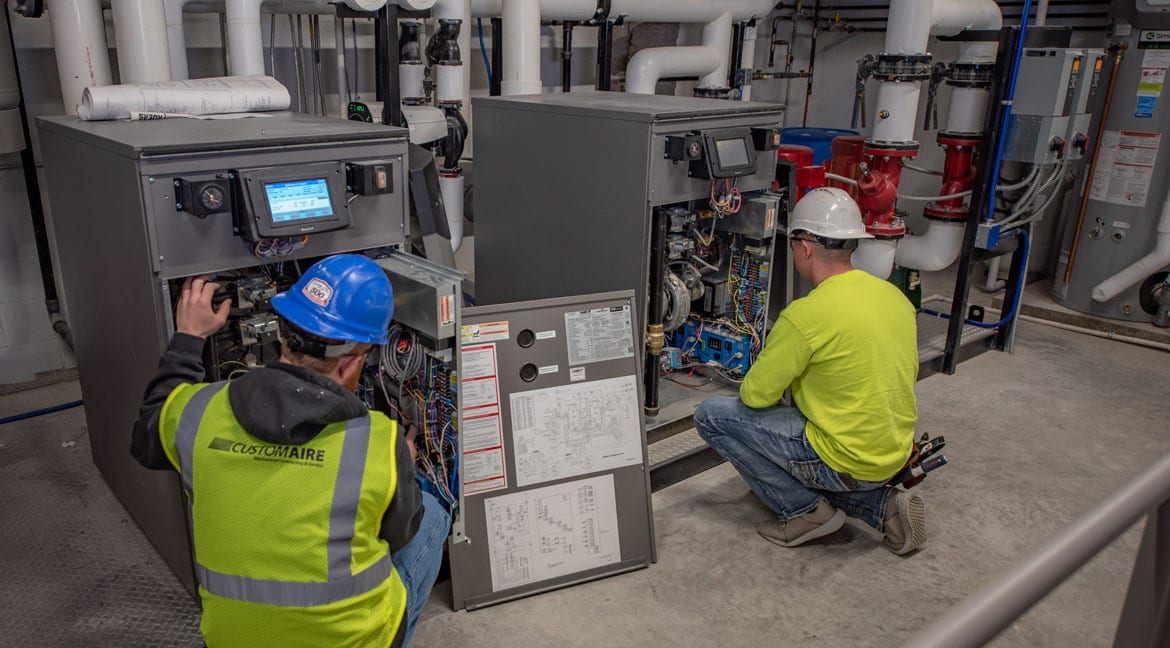Evaluating Brands for heat pump installation ooltewah tn
Evaluating Brands for heat pump installation ooltewah tn
Blog Article
How a Warmth Pump and Heater Job With Each Other to Maximize Your Home's Home heating Effectiveness
Recognizing just how a warmth pump and heating system work with each other is crucial for homeowners seeking effective heating services. Each system has its strengths, providing a balanced technique to home convenience. The warm pump excels in modest temperatures, while the furnace provides rapid heat during extreme cold. This synergy not only minimizes energy prices however also improves the lifespan of both home appliances. What elements affect this collaboration, and how can home owners optimize their benefits?
Understanding Warmth Pumps: Exactly How They Work
Although lots of people might be unfamiliar with their internal operations, warmth pumps play a necessary role in contemporary heating unit. These tools run by moving heat from one place to an additional, utilizing the concepts of thermodynamics. In cooler months, a heatpump essences warmth from the outside air, ground, or water, and transfers it indoors to warm the home. Conversely, throughout warmer months, it can turn around the procedure, functioning as an a/c by expelling warm from inside to the outside.Heat pumps include an evaporator, growth, compressor, and condenser valve. The refrigerant within the system soaks up heat as it vaporizes at reduced temperatures and pressures. The compressor after that increases the pressure and temperature level of the cooling agent, permitting it to release heat as it condenses. This efficient process can considerably minimize power intake contrasted to typical home heating approaches, making heatpump a sustainable choice for climate control in homes.
The Role of Furnaces in Home Heating
Heating systems play an important function in home heating by supplying a reliable resource of warmth during the cooler months. They run by creating warmth through burning or electrical resistance, dispersing it throughout the home by means of air ducts or radiant systems. The efficiency of a furnace is often measured by its Annual Gas Application Performance (AFUE) ranking, which shows just how successfully the system converts fuel into heat.Furnaces can use numerous energy sources, including gas, oil, gas, or power, permitting house owners to choose one of the most ideal choice for their needs. Unlike warmth pumps, which may struggle in severe cold, heaters maintain regular performance, making certain that indoor temperature levels remain comfy regardless of outside problems. Furthermore, modern-day heating systems typically come geared up with innovative technology, such as smart thermostats and variable-speed blowers, boosting their efficiency and responsiveness. This convenience makes furnaces a crucial element in all-encompassing home heating methods.

Advantages of Utilizing Both Solutions Together
Combining the toughness of both heaters and heatpump can bring about an extra effective and efficient home heating option. Utilizing both systems permits home owners to take benefit of the heatpump's energy performance throughout milder temperatures while counting on the heater for more severe cold conditions. This double technique can considerably decrease power expenses, as heat pumps eat less electricity than typical heating methods when temperature levels are moderate.Additionally, using both systems with each other can improve convenience levels in the home. Heatpump can supply consistent, also heating, while heaters can swiftly raise ambient temperature levels when needed. The assimilation of both systems can prolong the life-span of equipment by reducing wear and tear on each device, as they share the workload. Inevitably, property owners can enjoy a balanced, cost-efficient heating option that readjusts perfectly to differing weather, making sure a cozy and inviting home throughout the wintertime months.
How Warm Pumps and Furnaces Enhance Each Various Other
When property owners integrate heatpump and furnaces, they create a complementary heater that takes full advantage of performance and comfort. Heatpump operate by transferring warm from the outside air or ground, making them extremely reliable in modest environments. They succeed throughout milder temperatures, providing economical heating. Alternatively, heaters create warmth through combustion or electric resistance, delivering strong, immediate heat throughout severe chilly conditions.The combination of these 2 systems enables dynamic modifications based upon temperature level fluctuations. Throughout warmer months or milder winter months days, the heatpump can take the lead, preserving power and lowering prices. As temperature levels decrease, the heating system can perfectly engage, ensuring regular heat throughout the home. This synergy not just enhances energy use however likewise enhances the lifespan of both systems, as each device runs within its suitable performance range. With each other, they produce a balanced setting that adapts to differing environment demands.
Maximizing Effectiveness: Tips for Homeowners
Property owners can boost their home heating efficiency via a number of practical approaches. Establishing a regular upkeep routine, integrating wise thermostat technology, and implementing efficient insulation and sealing solutions are crucial steps. These procedures not only boost comfort yet also lower energy expenses.
Regular Maintenance Set Up
To ensure you could check here optimal heating performance, establishing a regular maintenance schedule is necessary for any home. Home owners ought to focus on regular examinations of both heat pumps and heating systems to determine peak efficiency. This consists of changing air filters every one to 3 months, as clogged filters can substantially minimize performance. Additionally, scheduling expert maintenance at the very least as soon as a year permits service technicians to identify and deal with prospective concerns prior to they escalate. House owners need to additionally clean the warm pump's outside device to stop debris accumulation that can prevent air movement. By sticking to a regular maintenance routine, home owners not just boost their heating unit' efficiency however additionally expand their lifespan, causing better convenience and reduced energy expenses throughout the cooler months.
Smart Thermostat Integration
Integrating a wise thermostat into a home heating system can significantly improve energy efficiency, particularly as it enables accurate control over temperature setups. These gadgets can learn the homeowner's timetable and preferences, automatically readjusting the temperature level to optimize convenience while decreasing power use. For instance, they can lower home heating throughout times when the home is unoccupied, lowering unneeded consumption. Many clever thermostats likewise provide real-time power usage information, allowing property owners to make informed choices about their home heating routines. Furthermore, anonymous remote gain access to using smart device apps enables users to adjust setups from anywhere, ensuring the home is cozy upon return. On the whole, smart thermostat assimilation not only boosts comfort yet considerably adds to energy cost savings and efficiency.
Insulation and Sealing Solutions
Smart thermostats play an important role in energy performance, but their effectiveness can be substantially improved by correct insulation and sealing options. Homeowners must prioritize shielding floors, attic rooms, and walls to minimize warm loss. Top quality insulation materials, such as spray foam or fiberglass, can greatly enhance thermal resistance. In addition, sealing voids around doors, ducts, and home windows stops chilly air infiltration and warmth escape. Weatherstripping and caulking work methods for resolving these leaks - heat pump installation ooltewah tn. Routine evaluations for air leaks, together with the anchor usage of blower door tests, can help recognize trouble locations. By spending in insulation and sealing, home owners can maximize the efficiency of their heating unit, eventually causing lowered power usage and reduced utility costs
Typical Myths About Heat Pumps and Furnaces
What misunderstandings surround heatpump and heaters? Lots of individuals mistakenly think that heatpump are inefficient in chillier climates. Actually, modern-day heatpump are developed to operate efficiently also in reduced temperatures, offering trusted home heating throughout winter months. One more typical myth is that furnaces are always more efficient than heatpump. This depends on the specific energy resources and efficiency rankings of the systems in inquiry. Some may also assume that utilizing both systems concurrently is unneeded, however in reality, this combination can maximize heating performance, particularly throughout severe climate conditions. Furthermore, individuals typically think that heat pumps require constant upkeep, when in reality, they have similar upkeep requires to traditional heating systems. By disproving these myths, homeowners can make more enlightened decisions regarding their home heating alternatives, inevitably causing improved comfort and power performance in their homes.
Maintenance Factors To Consider for Combined Systems

Often Asked Questions
Can Warm Pumps Work Effectively in Exceptionally Cold Climates?
Warmth pumps can have a hard time in incredibly cold climates due to decreased effectiveness and heat removal constraints. However, advancements in modern technology have caused versions developed for far better performance in such conditions, boosting their practicality in extreme environments.
Just How Long Do Heat Pumps and Furnaces Typically Last?
Heatpump commonly last 15 to twenty years, while heating systems have a lifespan of 15 to 30 years. Regular maintenance can extend their longevity, guaranteeing effective operation and decreasing the demand for premature replacements.

What Is the Typical Cost of Putting Up Both Solutions?
The ordinary expense of installing both a heatpump and a furnace typically varies in between $5,000 to $10,000 - heat pump replacement ooltewah tn. Elements affecting this expense include system dimension, installation complexity, and local labor rates
Exist Tax Motivations for Using Energy-Efficient Home Heating Systems?
Several house owners ask about tax obligation incentives for energy-efficient home heating systems. Various government and state programs typically offer discounts or debts, motivating the fostering of sustainable technologies to reduce power usage and promote environmental responsibility.
Just how Do I Select the Right Dimension Heat Pump and Heating System?
Selecting the ideal dimension heatpump and heater includes calculating the home's square video, considering insulation high quality, and evaluating regional environment. Consulting an expert can guarantee perfect system performance and power effectiveness based on specific demands. heat pump replacement ooltewah tn. Comprehending exactly how a warmth pump and heater job together is essential for house owners seeking effective heating services. In colder months, a warm pump removes heat from the outdoors air, ground, or water, and transfers it inside to warm the living area. When home owners integrate warm pumps and heaters, they develop a complementary heating system that optimizes performance and convenience. Heat pumps operate by moving warm from the outdoors air or ground, making them extremely reliable in moderate environments. Warm pumps can battle in very cool climates due to reduced performance and heat extraction restrictions
Report this page